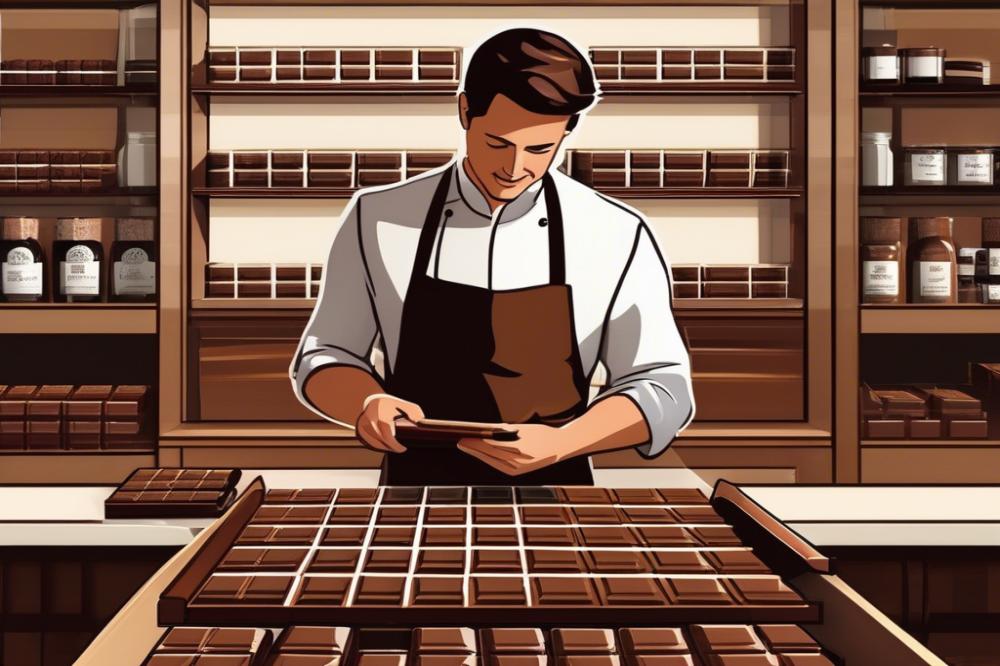Crafting single-estate chocolates: A New Trend
The chocolate industry has undergone remarkable changes over the years. Initially, most chocolates had a focus on mass production, often sacrificing quality for quantity. However, consumers today have shifted their preferences towards gourmet chocolates that offer superior taste and unique experiences. This desire has played a pivotal role in the rise of artisanal approaches, where craftsmanship takes precedence over mere output.
Recent years have witnessed the emergence of single-estate chocolates as a prominent trend. These chocolates are crafted from cacao sourced exclusively from one specific farm. Such practices enhance flavor profiling, allowing chocolate purveyors to highlight the distinct characteristics of each estate. This connection to the land not only supports small-batch production but also promotes sustainability, making each bite feel meaningful.
In addition, ethical chocolate sourcing practices build trust between consumers and producers. Many people now care about where their food comes from. When chocolates are produced using farm-to-table methods, it strengthens that connection. The emphasis on responsible cacao sourcing benefits both the environment and local communities. Thus, luxury chocolates are no longer just about sweetness or indulgence; they are about the story behind the bean-to-bar process. In this new age of chocolate, every flavor tells a tale worth savoring.
Understanding Single-Estate Chocolates

Single-estate chocolates are made from cacao sourced from one specific farm or location. These gourmet chocolates highlight the unique characteristics of the region where the cacao is grown. By focusing on a single origin, the flavors and aromas can shine through more distinctly compared to those in blended chocolates. Every bar tells a story of its place of origin and the conditions in which it was cultivated.
Blended chocolates, on the other hand, mix cacao from various locations. This approach can create a more uniform flavor profile, but it often lacks the depth of experience that single-origin products deliver. As consumers grow more interested in flavor profiling, the desire for distinct and authentic tastes becomes apparent. Cacao sourced from one estate can offer a range of flavors that reflect the terroir, similar to fine wines.
The benefits of single-origin sourcing are significant. For artisans, it provides a chance to showcase their skills through small-batch production. Each chocolate crafted can convey something special about the estate’s growing practices and the specific varietals of cacao used. This method promotes sustainability, as many estates focus on ethical chocolate practices, ensuring the well-being of both the environment and farmers.
For consumers, the appeal lies in tasting the luxury chocolates that come from a specific farm. The story behind each bite can make the experience far richer. Knowing that their purchase supports sustainable farming can enhance the enjoyment. Ethical chocolate is becoming increasingly important in today’s market, driving interest in artisanal products.
Chocolate purveyors are recognizing this shift. More shops are starting to offer single-estate options to meet the demands of a discerning clientele. The farm-to-table movement aligns perfectly with this trend, as both embrace transparency and quality over mass production. As people become more educated about where their food comes from, they’ll seek out chocolates that reflect their values.
Cacao Sourcing and Sustainability

The importance of ethical cacao sourcing cannot be overstated. People now care deeply about where their food comes from, including gourmet chocolates. Consumers are increasingly drawn to chocolate purveyors who practice responsible sourcing. This ethical approach benefits farmers and the environment alike.
Impactful sustainable practices reshape the entire chocolate production landscape. When chocolate makers adopt these methods, they prioritize the health of the planet. Small-batch production allows for a more careful selection of high-quality beans. This does not only produce better products; it also upholds the artisans behind these creations.
Farm-to-table methods are becoming popular in the chocolate industry. Locally sourced cacao fosters a direct relationship between farmers and consumers. Such connections can elevate flavor profiling in ways that mass production simply cannot. Artisanal chocolates thrive on these principles, creating a better experience for chocolate lovers.
However, challenges abound in maintaining sustainability. Not all farmers can afford the transition to organic or ethical practices. Economic pressure often forces them to choose short-term profits over long-term benefits. Likewise, consumers may not always be willing to pay extra for luxury chocolates that come from sustainable sources.
Creating a balance between demand and ethics is complex. Each step in cacao sourcing requires careful thought and commitment. Support for ethical chocolate can lead to positive changes in the industry. By prioritizing sustainability, everyone benefits—from the farmer to the final consumer.
Flavor Profiling in Single-Estate Chocolates

Flavor profiling in the world of chocolate has become a fascinating process. Understanding the details behind taste can elevate the experience of gourmet chocolates. Chocolate purveyors are diving deep into this art, unlocking the secrets of what makes each batch special. They use techniques like cupping, similar to coffee tasting, to explore the cocoa’s flavors more formally. This careful attention leads to a richer understanding of what goes into every bite.
How Terroir Influences the Taste
Terroir plays a crucial role in shaping the flavor characteristics of cacao beans. Factors like soil composition, climate, and altitude create distinct flavor profiles. Beans from a sunny region can yield bright and fruity notes, while those from cooler areas may develop rich and earthy tones. Each estate imparts its unique essence onto the chocolate. This connection between the land and the bean is what sets artisanal chocolates apart from mass-produced varieties.
Exploration of Unique Flavor Notes
Exploring flavor notes from different cacao estates reveals a mesmerizing diversity. One estate might yield hints of caramel, while another has floral undertones. Chocolates from the Caribbean often surprise with tropical fruit flavors, in contrast to those from Africa that may have spicier or deeper notes. This array enriches the chocolate experience, allowing connoisseurs to savor flavors that tell stories of their origin. Finding these subtle distinctions requires attention and appreciation for the craft.
Importance of Small-Batch Production
Small-batch production is vital in preserving these complex flavors. When chocolate is made in limited quantities, each step can be monitored closely. This hands-on approach helps in maintaining the integrity of the beans. Mass production often compromises taste for efficiency, missing the nuances that passionate makers emphasize. Farm-to-table practices also highlight the commitment to sustainability and ethical chocolate sourcing. Enthusiasts are drawn to these methods, knowing their chocolates come from responsible farms.
The Growth of Gourmet and Luxury Chocolates
The market for gourmet chocolates has witnessed remarkable expansion over the past few years. More consumers are seeking indulgence and quality in their sweet treats. As a result, chocolate purveyors are responding by diversifying their offerings to meet the heightened demand for luxurious options.
Trends in Gourmet Chocolates and Their Market Demand
New trends are emerging in the gourmet chocolate sector. With an increasing focus on sustainable practices, many chocolate makers are emphasizing ethical cacao sourcing. This approach not only appeals to conscious consumers but also highlights the importance of origin. Unique flavor profiling is another trend gaining traction. Chocolate lovers are eager to explore distinct taste experiences, pushing artisans to create innovative products.
Position of Single-Estate Chocolates Within the Luxury Chocolate Segment
Luxury chocolates have begun to incorporate single-estate chocolates as a key player. These offerings allow brands to showcase specific regions and their unique flavors. Consumers appreciate knowing where their chocolate comes from. Highlighting the journey of cacao from bean to bar adds an extra layer of value. This transparency is particularly appealing to upscale markets that prioritize authenticity.
Consumer Preferences for Artisanal and Premium Chocolate Products
Artisanal chocolates are especially popular among discerning consumers. They look for more than just a sweet treat; they want an experience. Small-batch production plays a significant role in this. Many believe that smaller quantities lead to superior quality. Shoppers often share their excitement for handcrafted items that feel special and unique.
Strategies for Chocolate Makers to Appeal to Upscale Markets
To attract the upscale market, chocolate makers need to adopt various strategies. Focusing on sustainable practices can create a strong narrative around the brand. Consumers today are eager to support companies that prioritize eco-friendly choices. Engaging storytelling about the origins of the cacao enhances consumer connections. Creating limited-edition releases can also drive excitement and exclusivity.
Overall, chocolate artisans are tapping into the growing interest in luxury chocolates by offering a richer experience. They can engage customers with stories of ethical chocolate and flavor exploration. The blend of craftsmanship and sustainability is what truly captivates chocolate enthusiasts.
Final Thoughts on the Rise of Single-Estate Chocolate
Significance of Single-Estate Chocolates
Crafting chocolates from a single estate reveals a broader story about flavor and quality. Each bar offers a taste that reflects its birthplace, showcasing the distinct notes of terroir. It is more than just a sweet treat; it is a journey through time and place. This trend promotes craftsmanship and elevates the often-overlooked farmers behind the scenes. By focusing on specific origins, chocolate lovers can explore new flavors while supporting sustainable practices.
Future Trends in Sustainability and Ethical Sourcing
The chocolate industry is shifting toward a more sustainable future. Many producers are realizing that ethical cacao sourcing is essential not only for the environment but also for their brands’ reputations. Certifications and transparency are becoming more common as consumers seek responsible choices. As this demand grows, it is likely that more companies will tell their stories and practices openly. This trend may lead to a stronger connection between consumers and producers, fostering trust and satisfaction.
Impact on Chocolate Lovers and Producers
Chocolate enthusiasts benefit greatly from artisanal creations that offer depth and character. Every bite is an invitation to appreciate intricate flavors and the hard work put into the process. For producers, the trend presents both challenges and opportunities. By adopting sustainable methods, they can attract a more conscious consumer base, aligning profit with purpose. Ultimately, the rise of crafted chocolates creates a vibrant space where flavors flourish and ethical practices thrive. As we enjoy these delightful treats, we also support a movement toward better practices within the industry.



